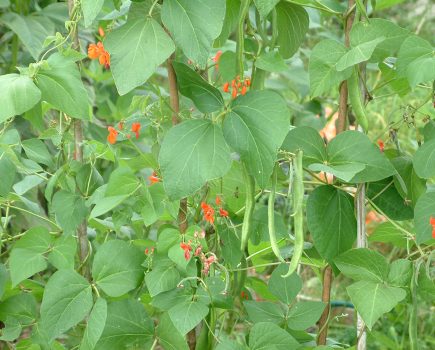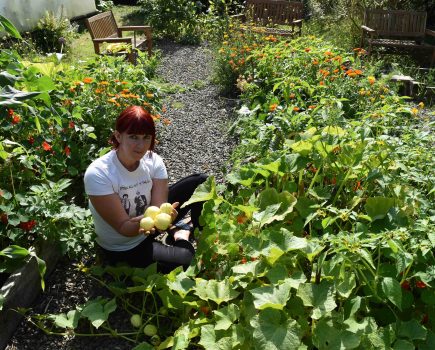Tim Tyne talks about keeping the smallholding cow
So, you want to produce your own milk, and perhaps you assume that goats are the answer. Think again. I suggest that you consider keeping a cow (or two). Seven years ago, we made the decision to switch over to cattle, and have never regretted the move. Having been a goat keeper myself for around 15 years, you will appreciate that it wasn’t an easy choice for me to make. However, within a very short time of buying our first cow and calf, we had realised that on the whole, the cow is cheaper to keep, easier to handle and more gentle than the majority of goats, and can be of real economic benefit to the smallholding. Our small herd now consists of five crossbred cows. They are capable of rearing between them more than 15 calves per year in addition to providing us with milk, cream, ice cream, yoghurt, some butter and occasionally cheese. This is from grazed grass, home grown hay and silage, and the barest minimum of bought in concentrates. Calves are sold as forward stores at between 16 and 20 months of age, and in a good year, they will average almost £500 a head (top price £730). We value the dairy produce for home consumption at around £50 a month, although this is, of course, a non- cash receipt. Spoilt for choice? Pay a visit to your local livestock market and see what types of cattle are selling regularly for good prices. Unfortunately you’re not likely to see a Gloucester, Longhorn, Shetland or any other of our picturesque older breeds. Why? Quite simply because their lack of commercial qualities has caused these breeds to fall by the wayside. If you intend to keep cattle purely as a hobby, and can afford to indulge your whim, then by all means choose a rarer breed – traditional breeds are an important part of our heritage and must be retained. If, however, you want your smallholding to keep you and not the other way around, then a commercial type animal should be chosen. The exception to this is where you plan to exploit a niche market for your products, although I suggest you make absolutely sure of your customers before buying stock. In the past it would have been appropriate to have recommended one of the ‘dual purpose’ breeds, but over the years, as farms have become more specialised, and with dairy farmers chasing ever higher yields, the traditional multi-purpose animal has been ousted by the Friesian and the Holstein. The old milking strains of the dual purpose cattle have been lost, and breeds such as the Welsh Black, British White, Red Poll and South Devon are now bred solely as beef producers. Although individual animals of a milky type can be found within these breeds, on the whole they’re unlikely to give a high enough level of production to be really viable on a small scale. Other pure beef breeds such as the Hereford, Aberdeen Angus and Charolais may also be disregarded as milkers, as these will produce sufficient for only one good calf. At the other end of the spectrum are the pure dairy breeds. These are, of course, capable nowadays of giving a huge quantity of milk daily, probably more than the average smallholder can cope with, and will require a proportionately high level of nutrition. High yields put considerable strain on the cow’s body systems resulting in increased susceptibility to metabolic disorders such as staggers (magnesium deficiency) and milk fever (calcium deficiency). It’s clear therefore that what is required is a ‘middle of the road’ type of animal, something akin to the old dual purpose breeds. Thankfully, nothing could be simpler to produce. Every dairy cow must be bred from annually so that her output can be maintained. As only a limited number of pure bred heifer calves are required each year for herd replacements, the vast majority of Britain’s dairy cows are bred to a beef bull. The resulting offspring are usually sold off the mother at a few days old, and the females are often reared on for entry into suckler herds. The combined qualities of their sire and dam make these crossbred cows very similar in type and temperament to the old multi-purpose breeds, and when they themselves are bred from, using a beef breed bull, the resulting three-quarter bred beef calves produce really high quality carcasses. Our own breed choice was based on reading sale reports in the Farmers Guardian. At the time all the prize winning beef animals seemed to have been sired by a Limousine bull, out of a Belgian Blue cross cow. When we went to view some newly calved cows for sale on a nearby farm and spotted amongst them a beautiful Belgian Blue X Friesian heifer with a Limousine sired calf at heel, it was not difficult to make up our minds. Not once have we regretted our choice of breed, and our first purchase, now around nine years of age, has been joined by four other Belgian Blue crosses. Another BBX heifer calf is being reared to join the herd. (Take note though, these are all ‘first cross’ animals out of dairy herds.) If, despite all this advice to the contrary, you still feel that a pure bred animal of one of the more traditional breeds is the thing for you, then the Dairy Shorthorn would probably fit the bill admirably. Many newcomers to the smallholding scene seem to be under the impression that the Dexter would be a suitable breed for the beginner, probably on account of its diminutive stature. Unfortunately, the Dexter is now so far removed from the old Kerry type cow from which it was developed to have nothing whatever to commend it to the true self-supporter, and is of interest only to the hobbyist. Don’t be misled into the assumption that the small size of the breed makes for easier handling. How often do we hear of a great cart horse being described as a ‘gentle giant’ whilst the little Shetland pony is frequently called a ‘cheeky sod’? The same applies to other classes of domestic stock – sheep, cattle and goats. Very short legged Dexters are at times rather fashionable, yet the gene that results in dwarfism in the breed also leads to a high proportion of grotesquely misshapen stillborn calves, and I have to say, I find the thought of anyone perpetuating these deformities in pursuit of a popular style to be somewhat appalling. Getting started If you’re new to cattle keeping, you may wish to start by rearing a calf. In this way you build up confidence with her as she grows, and by the time she herself calves at around two years of age, and it’s time to milk her, you will be so familiar with one another that there are unlikely to be any tantrums. By far the easiest way to get yourself a calf is to go directly to a local dairy farm and ask if they have any available, and if not, when will they or do they know of anyone who has? A Hereford X Friesian or an Aberdeen Angus X Friesian would make a perfect house cow, although any beef/dairy cross can be considered (with the exception perhaps of the Limousine/Friesian, which can be rather flighty). Buy two. Keep the one with whom you form the closest bond, and hopefully, the sale of the other when weaned will cover the costs of purchasing and rearing them both. (I’ll talk about calf rearing later in this series.) However, two years is a long time to wait before getting any milk. If you want to hit the ground running by purchasing an adult cow or perhaps an in-calf heifer, probably the simplest way to find yourself a suitable animal is to put the matter in the hands of a reputable livestock dealer. Dealers have unfortunately received some bad press in recent years, not least because of their supposed role in the spread of foot and mouth disease during the 2001 outbreak. It’s all too easy to point the finger of blame at someone. A livestock dealer is a very useful contact for the smallholder to have, as you will often find yourself with small numbers of stock to sell rather than the large batches of evenly matched animals favoured by the major buyers. A dealer working in conjunction with a number of smallholders can in effect co-ordinate the marketing of stock from those holdings. Many livestock dealers are themselves smallholders who have diversified into the buying and selling side of things to generate a bit of cash flow and make ends meet. They have nothing to gain (but their reputation to lose) by messing you about or ill treating your stock. Having made contact with such an individual, probably through the recommendation of another farmer or smallholder, give him a precise description of what it is you’re after. Over the next few weeks he’ll probably try to sell you all sorts of animals that are nearly what you’re looking for (remember, he is also acting on behalf of the seller, so will do his best to bring about a deal) but stick to your guns and eventually you will get exactly what you want. Sometimes the dealer will have bought the animal and moved it to his own premises for you to view her there. If she isn’t quite what you had in mind, don’t feel obliged to buy her – he probably has another half dozen or so potential purchasers lined up. Sometimes the dealer is content to simply act as an agent between you and the vendor, on the understanding that he will be given the job of transporting your purchase, and paid accordingly. This situation is preferable, as it enables you to view the cow on farm, talk to the owner and find out a bit more of her history. Even so, it can help to take with you a down-to-earth, stony-hearted, feet-in-the-mud friend to prevent you making purchases on impulse! If you still have reservations about livestock dealers, you could try classified advertisements but look out! Whereas a dealer won’t be at all perturbed if you don’t buy what he has on offer – he has, after all, a large network of regular buyers – the private advertiser will be keen to sell, and can be very persuasive. Your stony hearted companion may prove invaluable. Beware the single minded devotee of a particular (probably obscure) breed of cattle. You will be swamped by their enthusiasm as they extol the virtues of their chosen type, and they will convince you in no uncertain terms that these – and only these – provide the perfect answer to the smallholder’s dilemma as to what is the best cow for all management systems. As it happens, they have quite a few for sale, a small starter herd in fact, just the thing to get you going. By now of course, alarm bells should be ringing – why have they so much unsold stock? And why is there no stream of eager purchasers beating a path to the door? Buy them at your peril. A year or two down the line will see you in the same position with a now increased herd of cattle of a breed that no- one seems to want. You place an ad in the classifieds and sit with fingers crossed hoping, hoping, hoping that some newcomer to cattle keeping will buy the lot from you, as a starter herd perhaps… Further infomation The Shorthorn Society of United Kingdom and Ireland, 4th Street, National Agricultural Centre, Stonleigh Park, Kenilworth, Warwickshire CV8 2LG. Tel: 02476696549 Fax: 02476696729 Email: shorthorn@shorthorn.co.uk Website: www.shorthorn.co.uk
This article is from the March 2006 issue of Country Smallholding Magazine. Back issues of the magazine can be ordered by clicking on the link to the left.







